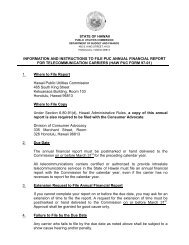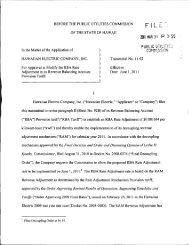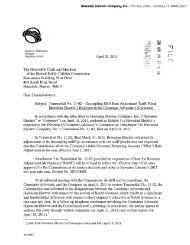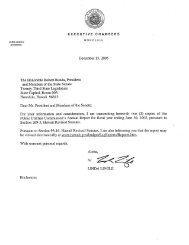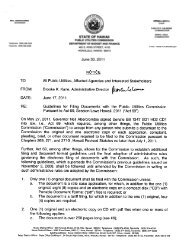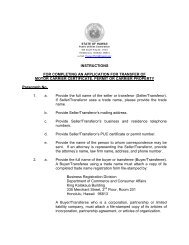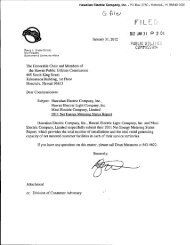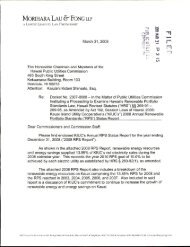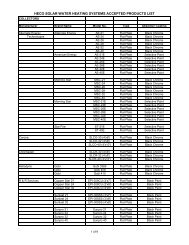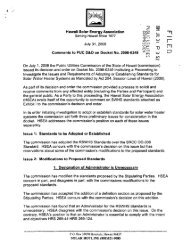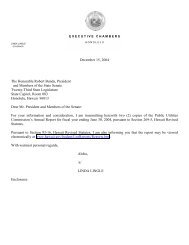PUC Annual ReportâFiscal Year 2011-12 - Public Utilities Commission
PUC Annual ReportâFiscal Year 2011-12 - Public Utilities Commission
PUC Annual ReportâFiscal Year 2011-12 - Public Utilities Commission
You also want an ePaper? Increase the reach of your titles
YUMPU automatically turns print PDFs into web optimized ePapers that Google loves.
<strong>Public</strong> <strong>Utilities</strong> <strong>Commission</strong> <strong>Annual</strong> Report <strong>2011</strong>-<strong>12</strong><br />
State of Hawaii Page 97<br />
Federal Issues and Activities<br />
EPA’s Mercury Air Toxics Standards (“MATS”)<br />
On December 21, <strong>2011</strong>, the U.S. Environmental Protection Agency (“EPA”)<br />
announced standards to limit mercury, acid gases and other toxic pollution from power<br />
plants, aimed at reducing air pollution from coal and oil-fired power plants. They set<br />
technology-based emissions limitation standards for mercury and other toxic air<br />
pollutants, reflecting levels achieved by sources currently in operation. The passing of<br />
the rule affects coal- and oil-fired electric generating units with a capacity of 25 MW or<br />
greater. Existing sources will have up to four years to comply with MATS. For more<br />
information please go to the EPA’s website on the subject:<br />
http://www.epa.gov/airquality/powerplanttoxics/index.html.<br />
Greenhouse Gas Prevention of Significant Deterioration and Tailoring<br />
Rule<br />
This EPA rule is part of their phase-in approach to permitting sources of<br />
greenhouse gas (“GHG”) emissions. On December 23, 2010, the EPA issued a series<br />
of rules that put the necessary regulatory framework in place to ensure that industrial<br />
facilities can get clean air act permits covering their GHG emissions when needed if<br />
necessary. The EPA tailoring rule ensures that only the largest sources of GHGs, those<br />
responsible for 70 percent of the GHG pollution from stationary sources, would require<br />
air permits. This rulemaking process is not yet complete. For more information, please<br />
go to the EPA’s website on the subject: http://www.epa.gov/NSR/actions.html.<br />
National Ambient Air Quality Standards (“NAAQS”)<br />
On August 31, <strong>2011</strong>, the EPA issued a ruling, effective October 31, <strong>2011</strong>, on its<br />
carbon monoxide standards, retaining the standards that were already in place and<br />
setting a compliance date of January 1, 2017 (for the size of the utilities in Hawaii). The<br />
primary standard for carbon monoxide is nine parts per million in an average eight hour<br />
period and thirty-five parts per million in a one hour period (both are not to be exceeded<br />
more than once per year. For more information about all of the NAAQS, please go to<br />
the EPA’s website: http://www.epa.gov/air/criteria.html. For more information on the<br />
carbon monoxide ruling, please see the Federal Register Volume 76, Number 169:<br />
http://www.gpo.gov/fdsys/pkg/FR-<strong>2011</strong>-08-31/html/<strong>2011</strong>-21359.htm.<br />
National Emission Standards for Hazardous Air Pollutants for<br />
Reciprocating Internal Combustion Engines (“RICE-NESHAP”)<br />
Though these proposed rule changes issued by the EPA do not become effective<br />
until the EPA issues a final regulation, the proposed amendments to the NESHAP for<br />
reciprocating internal combustion engines including replacing emission limits with<br />
(1) management practices for some engines that are remote from human activity or



